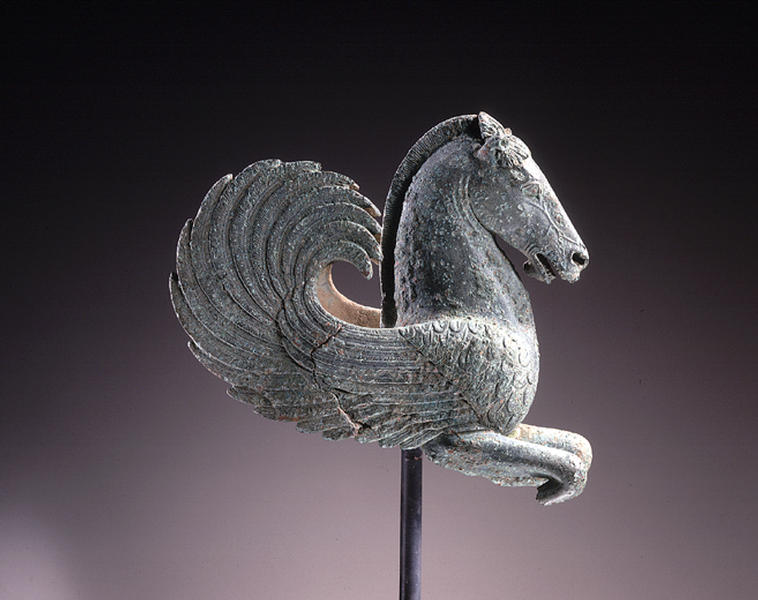ペガサス形装飾
- 前5世紀頃
- 青銅
- H-11.5 W-9.5
解説(古代バクトリア遺宝展)
前5世紀頃
青銅
高11.5 cm 長9.5 cm
このペガサス像は何かの装飾として作られたと思われるが、その精妙な作行きは小さいながら1個の堂々とした彫刻である。ここに見られる、翼を付け根と中間そして巻き上がった末端の三つで構成する様式は、アルカイク期の壺絵に表されたスフィンクス、セイレーン、ゴルゴンといった想像上の魔物の表現によく見られるものである。この小像の翼は、様式こそこのアルカイク期の要素を残しているが、現実味のある精緻な翼を作り出している。その頭部には鋭いまなざし、口元や顎の付近の皺、鼻筋の側面に浮き立つ血管などが精妙に表現され、巻き上がった翼とともに緊張の漲ったペガサスを迫真の表現力で作り上げている。これは恐らくギリシャ古典期初期の厳格様式に相当するものと思われる。同時代の類例としては、バチカン美術館所蔵、前5世紀エトルリアのペガサス形屋根装飾が挙げられるが、これも同様にアルカイクの風合いを残しながらギリシャ古典期厳格様式を示している。
ギリシャ神話によれば、有翼で不死身の馬ペガサスはメドゥーサの血から生まれ、英雄ベレロポンに飼いならされ、怪物退治に活躍した。英雄が神々と競いゼウスの怒りをかって落馬すると、ペガサスはゼウスの宮殿に昇り稲妻と稲光の運び手となった。この小像は神話の世界に登場する神馬の畏さを如実に伝えるものであり、この時代の最高に洗練された段階を示す作品であると言える。
Catalogue Entry
ca. 5th century B.C.
Bronze
H. 11.5 cm, L. 9.5 cm
This Pegasus image is thought to have originally been an ornament on some object, and for all of its small scale, it is a truly impressive example of detailed sculpture. The point of attachment of the wings, their middle section and their curving tips form a composition that can frequently be seen on such imaginary winged magical beings as the sphinxes, sirens and gorgons seen on Archaic vase painting. The style of the wings on this small Pegasus thus forms a remaining archaic element, while the wings themselves are created in a detailed sense of real wings. The face has a piercing gaze, and the wrinkles around the mouth and point of attachment of the jaw, the nostrils with their raised blood veins are all elements of this detailed expression, with the curved wings giving a sense of tension to the sculpture that adds to its life-like expressive power. These elements all accord with the severe style of the early period in Greek classical art. Similar examples from the same period can be found in the Vatican Museum's Pegasus shaped roof ornament from 5th century BC Etruria. Like the exhibited work, the Vatican Pegasus has the severe early classical Greek style combined with elements of the Archaic style. According to Greek myth, the immortal winged horse Pegasus was born from the blood of Medusa and was raised by the hero Bellerophon and engaged in fighting off monsters. The hero competed with the gods and this angered Zeus, who struck down the horse, turning Pegasus into the beast of burden who carried lightning bolts at Zeus's palace. This small sculpture gives a realistic depiction of the sacred horse's majesty as he appeared in the world of myth, and can be said to reveal the highest levels of refined artistry of this period.
